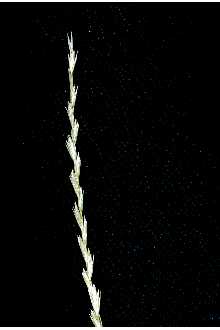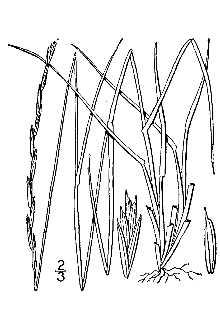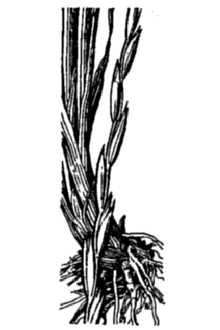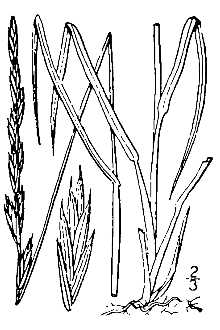Elymus trachycaulus (Link) Gould ex Shinners var. andinus (Scribn. & J.G. Sm.) Dorn
Scientific Name: Elymus trachycaulus (Link) Gould ex Shinners var. andinus (Scribn. & J.G. Sm.) Dorn
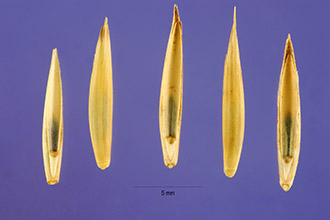
| General Information | |
|---|---|
| Usda Symbol | ELTRA3 |
| Group | Monocot |
| Life Cycle | Perennial |
| Growth Habits | Graminoid |
| Native Locations | ELTRA3 |
Plant Guide
Alternate Names
Agropyron trachycaulum, Agropyron caninum var. andinum.
Uses
Grazing/rangeland/pasture: Slender wheatgrass is both palatable and nutritious to livestock. Crude protein averages 22 to 25% in the spring and drops below 10% in late summer to fall. Average dry matter yield is between 1000 and 2300 lb/acre. Wildlife: Upland game birds and small mammals utilize the seed for food and the foliage for cover. Large ungulates, especially elk and bighorn sheep at higher elevations, readily graze this species. Erosion control: Slender wheatgrass is a short-lived perennial with good seedling vigor. It germinates and establishes quickly when seeded making it a good choice for quick cover on disturbed sites. It persists long enough for other, slower developing components of seeding mixtures to establish. Jeanne R. Janish. 1977. © The New York Botanical Garden Reclamation: Slender wheatgrass was among the first native grasses widely used for reclamation seedings in western Canada and the U.S. It has been successfully used for the reclamation of mine spoils, oil sands, roadsides right-of-ways, wildfire areas and other disturbed sites. It is especially valuable for use in saline soils.
Legal Status
Status
Status
Consult the PLANTS Web site and your State Department of Natural Resources for this plant’s current status (e.g. threatened or endangered species, state noxious status, and wetland indicator values).
Taxonomy
Historically, slender wheatgrass has borne many different names. Carl Linnaeus originally placed all wheatgrasses in the genus Triticum along with cultivated wheat. Later authors classified slender wheatgrass as Agropyron caninum, however, it was separated to A. trachycaulum from that Old World species by having broader glumes (5 to 7 nerves instead of 3), glumes with membranous margins (not rigid), and having anthers averaging 1.5 mm long as opposed to 2mm. More recently, it was decided through the use of molecular, morphological and cladistic analysis that in North America, the genus Agropyron should be left to the introduced crested wheatgrass complex (A. cristatum, A. desertorum and A. fragile), which moved slender wheatgrass to the genus Elymus. This move also required the change of the epithet to trachycaulus in order to match the Latin genders.
Description
General: Grass Family (Poaceae). Slender wheatgrass is an erect, tufted, bunchgrass ranging in height from 2 to 2-1/2 feet. It is a relatively short-lived (3 to 5 years) perennial, cool-season C3 type, bunchgrass native to Western North America. Plants are perennial, occasionally producing short rhizomes. Culms are erect or decumbent at the base, reaching a height of 0.5 to 1.0 meters (20 to 40 inches) tall. Stems are noted as having a characteristic reddish to purplish tinge at the base. The leaves are flat, usually 2 to 8 mm (0.08 to 0.31 inches) wide, stiffly ascending or somewhat lax. Sheathes are commonly glabrous or somewhat scabrous with auricles short or lacking. The inflorescence is a long, spicate raceme ranging from 5 to as much as 25 cm (2 to 10 inches) long. Spikelets are solitary at each node of the rachis, 3 to 7 flowered and about 10 to 20 mm (0.4 to 0.8 inches) long. Spikelets overlap along the inflorescence, the rachis internodes being 5 to 8 mm (0.2 to 0.3inches) long. Glumes are lanceolate to oblong with 5 to 7 nerves. The first glume ranges from 6 to 10 mm (0.24 to 0.4 inches) long, while second glumes are slightly longer, from 7 to 12 mm (0.3 to 0.5 inches).
Distribution
Slender wheatgrass is found in many plant communities including Wyoming, basin and mountain big sagebrush, mountain brush, aspen, ponderosa pine, spruce-fir and lodgepole pine. It is found from 1300 to 3500 meters (4,500 to 12,000 feet) in elevation. The species range includes Canada, Siberia, Mexico and all states except those in the southeastern U.S. For current distribution, please consult the Plant Profile page for this species on the PLANTS Web site.
Adaptation
Slender wheatgrass grows naturally in moist to dry sites receiving more than 250 mm (10 inches) annual precipitation. This species is not as drought tolerant as crested, thickspike and streambank wheatgrasses and may succumb to drought due to its late maturation. It prefers loamy to clayey soils and grows at elevations from 1,300 to 3,500 meters (4,500 to 12,000 feet). Slender wheatgrass is well adapted to basic soils (up to pH=8.8) and moderately saline conditions with a salinity tolerance ranging from 10 to 20 mmhos/cm.
Establishment
Seeds should be planted in a firm, weed-free seed bed. Dormant fall planting is preferred for dryland seedings made in areas receiving less than 16 inches mean annual precipitation. Areas receiving over 16 inches of mean annual precipitation and fields that are irrigated can be seeded in late fall or early spring. (Note: dormant fall seedings are more prone to be negatively affected by soil crusting and mid to late spring seedings are more prone to drying out). Seeds should be drilled to a depth of ¼ to ¾ inch at a Pure Live Seed (PLS) rate of approximately 6 lb PLS/acre for field plantings. For critical area plantings, turf applications and broadcast plantings the PLS seeding rate should be 1.5 to 2.0 times the drill seeding rate. For native seed mixtures, limit slender wheatgrass to 1 to 2 pounds PLS/acre because higher rates effect the establishment of slower developing native species. Fertilizer is not recommended for establishment, as it usually benefits the weeds. On disturbed sites fertilizer should be applied according to soil test results.
Management
Slender wheatgrass is best suited as a filler component in seed mixtures containing slower establishing, long-lived perennials. It does well for hay and pasture when combined with legumes. Because this species is short-lived and only moderately tolerant of grazing, stands should be managed carefully to ensure seed production occurs every other year for long-term survival.
Environmental Concerns
Concerns , Use soil moisture sensors to measure the soil moisture of Elymus trachycaulus (Link) Gould ex Shinners var. andinus (Scribn. & J.G. Sm.) Dorn.
Concerns
Although slender wheatgrass is native to Western North America, it can be viewed as “weedy” due to its ability to quickly establish in disturbed areas. Please consult with your local NRCS Field Office, Cooperative Extension Service Office or state natural resource or agriculture department regarding this species’ status and use. Weed information is also available from the PLANTS Web site.
Seed Production
Plant at a rate of approximately 3.4 pounds PLS/acre or 25 to 30 seeds per linear foot of drill row at 36 inch row spacing. For stand establishment, apply 55 lb/acre of 11-55-0 (high phosphorus fertilizer) as a soil amendment prior to planting or during seeding. If planting into grain stubble, after initial seedling establishment, apply 30 lb/acre nitrogen for dryland or 60 to 80 lb/acre nitrogen for irrigated fields. No additional nitrogen is necessary if planting into summer fallow. Irrigate enough to keep soil moist for establishment and to prevent soil crusting. Seeds should germinate within 8 to 10 days. Weeds can be controlled after the 3 to 5 leaf stage with low rates of Bromoxynil. Be sure to read and follow all label directions when using any pesticide. Caution should be exercised when using cultivation on young seedlings because of the possibility of uprooting. For established stands, apply 50 lb/acre nitrogen each year in late fall on dryland and 60 to 80 lb/acre nitrogen in late fall under irrigation. On established stands keep soil moisture above fifty percent field capacity during the growth period. Before the flowering stage apply enough water to carry plants through pollination. After pollination, irrigate to recharge the soil profile for seed set. Control weeds chemically (Bromoxynil, Metribuzin, 2,4-D or dicamba), by roguing or mechanical cultivating. Seed is ready for harvest in late July to early August. The recommended harvest method is by direct combining or by swathing followed by combining. Windrows should be allowed to dry in the field for 6 to 7 days before combining. Seed yields range from 200 to 400 lb/acre in dryland to 500 to 600 lb/acre under irrigation. Seed should be dried to 12 percent or less moisture prior to storage. When stored properly, cleaned seed should retain its viability for about five years. Stands can be expected to survive for 3 to 5 years.
Pests and Potential Problems
No insect or disease problems have been noted for this species. Cultivars, Improved, and Selected Materials ‘Adanac’ was released by the Agriculture Canada, Saskatoon Research Station and the Agriculture Canada Experiment Farm in 1990. Plants are taller than those of Revenue, but have fewer leaves. Adanac averaged 7% higher hay yields than Revenue during a four-year study. Adanac also rated higher than Revenue in establishment, persistence, seed yield and productivity under saline conditions. However, digestibility and protein content are somewhat below those of Revenue. This release is recommended for use in Saskatchewan, Canada. Breeder seed is maintained by the Agriculture Canada, Saskatoon Research Station and the Agriculture Canada Experiment Farm, Indian Head. ‘Elbee’ was released in 1980 by S. Smoliak and A. Johnson of Agriculture Canada Research Station, Lethbridge, Alberta. This is an eight-clone synthetic variety selected for aggressiveness of rhizomes, and forage and seed yields. This variety has excellent germination, high seedling vigor, drought tolerance, early spring growth and an aggressive root system. It is primarily intended for range and pasture seedings in the dark soil zones of the prairies as well as for revegetation of roadsides and industrial disturbances. Breeder seed is available through Agriculture Canada Research Station, Lethbridge, Alberta. ‘AEC Hillcrest’ was released by the Alberta Environmental Centre in 1994. Its primary uses are in reclaiming and revegetation of disturbed sites in the mountains and foothills of Alberta. This cultivar belongs to a different subspecies than the others discussed here (Elymus trachycaulus ssp. subsecundus) and is therefore difficult to compare directly. Data show AEC Hillcrest producing similar plant cover to Revenue at elevations around 1800 meters. Hillcrest seeds also tend to ripen two weeks earlier than Revenue, an important quality in the shortened growing season of Alberta. Breeder seed is maintained by the Alberta Environmental Centre, Vegreville, Alberta. Foundation and Certified seed is maintained by Peace Valley Seeds, Rycroft, Alberta. ‘Primar’ was released by the NRCS Plant Materials Center in Pullman, Washington in 1946. Originally collected near Beebe, Montana, Primar was selected for use in sweetclover-grass conservation mixtures for pasture, hay and green manure. Plants are high in vegetative production and show resistance to leaf rust, stem rust and stripe rust. This cultivar is adapted to short-lived dryland seedings in areas receiving over 16” annual precipitation. Pullman Plant Materials Center maintains Breeder seed and Washington Crop Improvement Association maintain Foundation seed. ‘Pryor’ was released cooperatively by the NRCS Plant Materials Center in Bridger, Montana and the Montana and Wyoming Agricultural Experiment Stations in 1988. The original collection was made in Carbon County, Montana, five miles north of Warren. It is superior to other previously released slender wheatgrasses in drought tolerance, saline tolerance and seedling vigor. It also matures earlier and has a larger mean seed size (213,000 seeds/kg compared to 320,000 seeds/kg). For these reasons it is used primarily in mixtures for reclamation and conservation plantings in low precipitation, alkali conditions. Breeder and Foundation seed are maintained by the NRCS Plant Materials Center, Bridger, Montana. ‘Revenue’ was originally collected in Saskatchewan in 1961. It was selected from over 750 native and introduced collections evaluated between 1959 and 1969 and released in 1970 by the Canada Department of Agriculture. Revenue is said to be superior to Primar in establishment, forage and seed yield and in salinity tolerance. It also has a higher leaf-to-stem ratio, better digestibility and greater smut resistance than Primar. It is similar to Primar in maintaining good stands for three to five years. It is adapted for use on saline soils and in short pasture rotations. Breeder seed is maintained by the Canada Department of Agriculture. ‘San Luis’ was released cooperatively in 1984 by Colorado, and New Mexico Agricultural Experiment Stations, NRCS, and the Upper Colorado Environmental Plant Center. The original collection was made by Glenn Niner in 1975 near Center, San Luis Valley, Rio Grande County, Colorado. Due to its outstanding rapid establishment and longevity it is well suited for soil stabilization on slopes and disturbed sites. It performs best above 1,800 meters elevation in areas receiving over 35 cm (14 inches) of annual precipitation. It is recommended for ski slopes, roadsides, mine land reclamation and transmission corridors. Breeder and Foundation seed is maintained by the Upper Colorado Environmental Plant Center, Meeker, Colorado.
Plant Traits
Growth Requirements
| Fertility Requirement | Medium |
|---|---|
| Cold Stratification Required | No |
| Cold Stratification Required | No |
| Cold Stratification Required | No |
| Cold Stratification Required | No |
| Cold Stratification Required | Yes |
| Drought Tolerance | High |
| Drought Tolerance | High |
| Drought Tolerance | Low |
| Drought Tolerance | Medium |
| Drought Tolerance | Medium |
| Fertility Requirement | Medium |
| Fertility Requirement | Medium |
| CaCO3 Tolerance | Medium |
| Fertility Requirement | Medium |
| Fertility Requirement | Medium |
| Fire Tolerance | High |
| Fire Tolerance | High |
| Fire Tolerance | High |
| Fire Tolerance | High |
| Fire Tolerance | Medium |
| Frost Free Days, Minimum | 90 |
| Frost Free Days, Minimum | 90 |
| Frost Free Days, Minimum | 90 |
| Frost Free Days, Minimum | 90 |
| Frost Free Days, Minimum | 90 |
| Adapted to Medium Textured Soils | Yes |
| Adapted to Coarse Textured Soils | No |
| Adapted to Coarse Textured Soils | No |
| Adapted to Coarse Textured Soils | No |
| Adapted to Coarse Textured Soils | No |
| Adapted to Coarse Textured Soils | No |
| Adapted to Fine Textured Soils | Yes |
| Adapted to Fine Textured Soils | Yes |
| Adapted to Fine Textured Soils | Yes |
| Adapted to Fine Textured Soils | Yes |
| Adapted to Fine Textured Soils | Yes |
| Adapted to Medium Textured Soils | Yes |
| Adapted to Medium Textured Soils | Yes |
| Temperature, Minimum (°F) | -43 |
| Adapted to Medium Textured Soils | Yes |
| Adapted to Medium Textured Soils | Yes |
| Anaerobic Tolerance | Low |
| Anaerobic Tolerance | Low |
| Anaerobic Tolerance | Low |
| Anaerobic Tolerance | Low |
| Anaerobic Tolerance | None |
| CaCO3 Tolerance | High |
| CaCO3 Tolerance | High |
| CaCO3 Tolerance | Low |
| CaCO3 Tolerance | Medium |
| Salinity Tolerance | Medium |
| Precipitation, Minimum | 10 |
| Precipitation, Minimum | 14 |
| Precipitation, Minimum | 14 |
| Precipitation, Minimum | 16 |
| Precipitation, Minimum | 8 |
| Root Depth, Minimum (inches) | 16 |
| Root Depth, Minimum (inches) | 16 |
| Root Depth, Minimum (inches) | 16 |
| Root Depth, Minimum (inches) | 16 |
| Root Depth, Minimum (inches) | 16 |
| Salinity Tolerance | Medium |
| Salinity Tolerance | Medium |
| Hedge Tolerance | None |
| Salinity Tolerance | Medium |
| Salinity Tolerance | Medium |
| Shade Tolerance | Intolerant |
| Shade Tolerance | Intolerant |
| Shade Tolerance | Intolerant |
| Shade Tolerance | Intolerant |
| Shade Tolerance | Intolerant |
| Temperature, Minimum (°F) | -33 |
| Temperature, Minimum (°F) | -38 |
| Temperature, Minimum (°F) | -38 |
| Temperature, Minimum (°F) | -43 |
| Precipitation, Maximum | 25 |
| Hedge Tolerance | None |
| Hedge Tolerance | None |
| Hedge Tolerance | None |
| Hedge Tolerance | None |
| Moisture Use | Low |
| Moisture Use | Low |
| Moisture Use | Medium |
| Moisture Use | Medium |
| Moisture Use | Medium |
| pH, Maximum | 7.2 |
| pH, Maximum | 9.0 |
| pH, Maximum | 9.0 |
| pH, Maximum | 9.0 |
| Precipitation, Maximum | 40 |
| Precipitation, Maximum | 25 |
| Precipitation, Maximum | 24 |
| Precipitation, Maximum | 24 |
| pH, Minimum | 6.0 |
| pH, Minimum | 5.6 |
| pH, Minimum | 5.6 |
| pH, Minimum | 5.6 |
| pH, Minimum | 5.6 |
| pH, Maximum | 9.0 |
Morphology/Physiology
| Resprout Ability | No |
|---|---|
| Resprout Ability | No |
| Resprout Ability | No |
| Resprout Ability | No |
| Shape and Orientation | Erect |
| Shape and Orientation | Erect |
| Shape and Orientation | Erect |
| Shape and Orientation | Rounded |
| Shape and Orientation | Semi-Erect |
| Toxicity | None |
| Toxicity | None |
| Toxicity | None |
| Toxicity | None |
| Toxicity | None |
| Active Growth Period | Spring |
| Flower Conspicuous | No |
| Fall Conspicuous | No |
| Fire Resistant | No |
| Fire Resistant | No |
| Fire Resistant | No |
| Fire Resistant | No |
| Fire Resistant | Yes |
| Flower Color | Yellow |
| Flower Color | Yellow |
| Flower Color | Yellow |
| Flower Color | Yellow |
| Flower Color | Yellow |
| Flower Conspicuous | No |
| Flower Conspicuous | No |
| Flower Conspicuous | No |
| Fall Conspicuous | No |
| Flower Conspicuous | No |
| Foliage Color | Green |
| Foliage Color | Green |
| Foliage Color | Green |
| Foliage Color | Green |
| Foliage Color | Green |
| Foliage Porosity Summer | Dense |
| Foliage Porosity Summer | Dense |
| Foliage Porosity Summer | Moderate |
| Foliage Porosity Summer | Moderate |
| Foliage Porosity Summer | Moderate |
| Foliage Porosity Winter | Moderate |
| Foliage Porosity Winter | Porous |
| Bloat | None |
| Resprout Ability | No |
| Active Growth Period | Spring |
| Active Growth Period | Spring |
| Active Growth Period | Spring |
| Active Growth Period | Spring |
| After Harvest Regrowth Rate | Moderate |
| After Harvest Regrowth Rate | Moderate |
| After Harvest Regrowth Rate | Moderate |
| After Harvest Regrowth Rate | Moderate |
| After Harvest Regrowth Rate | Slow |
| Bloat | None |
| Bloat | None |
| Bloat | None |
| Bloat | None |
| Nitrogen Fixation | None |
| C:N Ratio | Medium |
| C:N Ratio | Medium |
| C:N Ratio | Medium |
| C:N Ratio | Medium |
| C:N Ratio | Medium |
| Coppice Potential | No |
| Coppice Potential | No |
| Coppice Potential | No |
| Coppice Potential | No |
| Coppice Potential | No |
| Fall Conspicuous | No |
| Fall Conspicuous | No |
| Fall Conspicuous | No |
| Lifespan | Long |
| Height, Mature (feet) | 3.0 |
| Height, Mature (feet) | 3.0 |
| Height, Mature (feet) | 3.0 |
| Height, Mature (feet) | 3.0 |
| Known Allelopath | No |
| Known Allelopath | No |
| Known Allelopath | No |
| Known Allelopath | No |
| Known Allelopath | No |
| Leaf Retention | No |
| Leaf Retention | No |
| Leaf Retention | No |
| Leaf Retention | No |
| Leaf Retention | No |
| Foliage Porosity Winter | Porous |
| Lifespan | Long |
| Lifespan | Long |
| Lifespan | Moderate |
| Lifespan | Moderate |
| Low Growing Grass | No |
| Low Growing Grass | No |
| Low Growing Grass | No |
| Low Growing Grass | No |
| Low Growing Grass | No |
| Nitrogen Fixation | None |
| Nitrogen Fixation | None |
| Nitrogen Fixation | None |
| Nitrogen Fixation | None |
| Growth Rate | Rapid |
| Height, Mature (feet) | 2.0 |
| Foliage Porosity Winter | Porous |
| Foliage Porosity Winter | Porous |
| Foliage Texture | Fine |
| Foliage Texture | Medium |
| Foliage Texture | Medium |
| Foliage Texture | Medium |
| Foliage Texture | Medium |
| Fruit/Seed Color | Brown |
| Fruit/Seed Color | Brown |
| Fruit/Seed Color | Brown |
| Fruit/Seed Color | Brown |
| Fruit/Seed Color | Brown |
| Fruit/Seed Conspicuous | No |
| Fruit/Seed Conspicuous | No |
| Fruit/Seed Conspicuous | No |
| Growth Rate | Rapid |
| Growth Rate | Rapid |
| Growth Rate | Moderate |
| Growth Rate | Moderate |
| Growth Form | Rhizomatous |
| Growth Form | Bunch |
| Growth Form | Bunch |
| Growth Form | Bunch |
| Fruit/Seed Conspicuous | No |
| Fruit/Seed Conspicuous | No |
| Growth Form | Bunch |
Reproduction
| Propagated by Sod | No |
|---|---|
| Propagated by Sprigs | No |
| Propagated by Sprigs | No |
| Propagated by Sprigs | No |
| Propagated by Sprigs | No |
| Propagated by Sprigs | No |
| Propagated by Tubers | No |
| Propagated by Tubers | No |
| Propagated by Tubers | No |
| Propagated by Tubers | No |
| Propagated by Tubers | No |
| Fruit/Seed Persistence | No |
| Propagated by Sod | No |
| Propagated by Sod | No |
| Propagated by Sod | No |
| Propagated by Sod | No |
| Propagated by Seed | Yes |
| Propagated by Seed | Yes |
| Propagated by Seed | Yes |
| Propagated by Seed | Yes |
| Propagated by Seed | Yes |
| Propagated by Cuttings | No |
| Propagated by Cuttings | No |
| Propagated by Cuttings | No |
| Propagated by Cuttings | No |
| Seedling Vigor | High |
| Vegetative Spread Rate | None |
| Vegetative Spread Rate | None |
| Vegetative Spread Rate | None |
| Vegetative Spread Rate | None |
| Vegetative Spread Rate | Moderate |
| Small Grain | No |
| Small Grain | No |
| Small Grain | No |
| Small Grain | No |
| Small Grain | No |
| Seedling Vigor | Medium |
| Seedling Vigor | High |
| Seed per Pound | 135000 |
| Seedling Vigor | High |
| Seedling Vigor | High |
| Seed Spread Rate | Slow |
| Seed Spread Rate | Slow |
| Seed Spread Rate | Slow |
| Seed Spread Rate | Slow |
| Seed Spread Rate | Moderate |
| Seed per Pound | 159000 |
| Seed per Pound | 135000 |
| Seed per Pound | 135000 |
| Seed per Pound | 135000 |
| Fruit/Seed Abundance | High |
| Fruit/Seed Period End | Summer |
| Fruit/Seed Period End | Summer |
| Fruit/Seed Period End | Summer |
| Fruit/Seed Period End | Spring |
| Fruit/Seed Period Begin | Spring |
| Fruit/Seed Period Begin | Spring |
| Fruit/Seed Period Begin | Spring |
| Fruit/Seed Period Begin | Spring |
| Fruit/Seed Period Begin | Spring |
| Fruit/Seed Abundance | Low |
| Fruit/Seed Abundance | High |
| Fruit/Seed Abundance | High |
| Propagated by Corm | No |
| Fruit/Seed Abundance | High |
| Commercial Availability | Routinely Available |
| Commercial Availability | Routinely Available |
| Commercial Availability | Routinely Available |
| Commercial Availability | Routinely Available |
| Commercial Availability | Routinely Available |
| Bloom Period | Spring |
| Bloom Period | Late Spring |
| Bloom Period | Late Spring |
| Bloom Period | Late Spring |
| Bloom Period | Late Spring |
| Propagated by Cuttings | No |
| Fruit/Seed Persistence | No |
| Fruit/Seed Period End | Summer |
| Propagated by Corm | No |
| Propagated by Corm | No |
| Propagated by Corm | No |
| Propagated by Corm | No |
| Propagated by Container | No |
| Propagated by Container | No |
| Propagated by Container | No |
| Propagated by Container | No |
| Propagated by Container | No |
| Propagated by Bulb | No |
| Propagated by Bulb | No |
| Propagated by Bulb | No |
| Propagated by Bulb | No |
| Fruit/Seed Persistence | No |
| Fruit/Seed Persistence | No |
| Fruit/Seed Persistence | No |
| Propagated by Bare Root | No |
| Propagated by Bare Root | No |
| Propagated by Bare Root | No |
| Propagated by Bare Root | No |
| Propagated by Bare Root | No |
| Propagated by Bulb | No |
Suitability/Use
| Post Product | No |
|---|---|
| Post Product | No |
| Post Product | No |
| Post Product | No |
| Palatable Human | No |
| Palatable Human | No |
| Palatable Human | No |
| Palatable Human | No |
| Palatable Human | No |
| Palatable Graze Animal | Medium |
| Palatable Graze Animal | High |
| Palatable Graze Animal | High |
| Palatable Graze Animal | High |
| Palatable Graze Animal | High |
| Palatable Browse Animal | Low |
| Palatable Browse Animal | High |
| Post Product | No |
| Protein Potential | Medium |
| Protein Potential | Medium |
| Protein Potential | Medium |
| Protein Potential | Medium |
| Protein Potential | Medium |
| Pulpwood Product | No |
| Pulpwood Product | No |
| Pulpwood Product | No |
| Pulpwood Product | No |
| Pulpwood Product | No |
| Veneer Product | No |
| Veneer Product | No |
| Veneer Product | No |
| Veneer Product | No |
| Veneer Product | No |
| Christmas Tree Product | No |
| Lumber Product | No |
| Fodder Product | Yes |
| Fodder Product | Yes |
| Fodder Product | Yes |
| Fodder Product | Yes |
| Fodder Product | Yes |
| Christmas Tree Product | No |
| Christmas Tree Product | No |
| Lumber Product | No |
| Christmas Tree Product | No |
| Christmas Tree Product | No |
| Berry/Nut/Seed Product | No |
| Berry/Nut/Seed Product | No |
| Berry/Nut/Seed Product | No |
| Berry/Nut/Seed Product | No |
| Berry/Nut/Seed Product | No |
| Palatable Browse Animal | High |
| Lumber Product | No |
| Lumber Product | No |
| Lumber Product | No |
| Naval Store Product | No |
| Naval Store Product | No |
| Naval Store Product | No |
| Naval Store Product | No |
| Naval Store Product | No |
| Nursery Stock Product | No |
| Nursery Stock Product | No |
| Nursery Stock Product | No |
| Nursery Stock Product | No |
| Nursery Stock Product | No |
| Palatable Browse Animal | High |
| Palatable Browse Animal | High |
